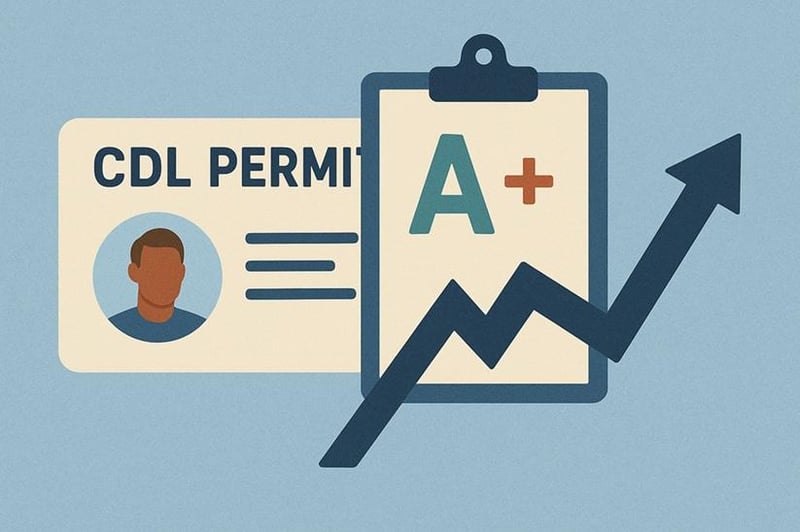Techniques to Help Your Trainees Pass on the First Try
This guide is designed for fleet supervisors, training coordinators, and operations managers tasked with improving permit exam success rates under Federal Motor Carrier Safety Administration (FMCSA) regulations.
Background
Getting new drivers licensed as quickly and efficiently as possible is vital for fleets nationwide that are facing driver shortages. The CDL permit exam, or General Knowledge test, is the first major hurdle in that process. Many new trainees struggle to pass on their first attempt. Nationally, first-time pass rates reportedly hover around 50%, creating unnecessary delays and increasing costs. Training programs such as Driving-Tests.org’s CDL Premium program report high CDL test pass rates of 95%, strongly suggesting that CDL permit test training tips and proper test preparation make a significant difference.
Top 10 Tips to Improve CDL Exam Pass Rates
- Use Exam-Like Practice Tests
Simulated tests are proven to increase memory retention and reduce test-day anxiety. It is important to use a platform that mirrors the format and style of the official CDL permit exam. Additionally, scheduling regular (at least once weekly) practice exams will ensure steady progress; the repetition reinforces the student’s knowledge and accustoms them to the actual testing environment.
Realistic practice tests under similar conditions to the real test environment are of obvious importance. These conditions should include limitations on note-taking and distractions. The key is to introduce all elements of the actual testing environment within the practice environment so that no test-day surprises (and the stress they may cause) occur. Consider assigning retakes for any student scoring below a set benchmark to ensure all categories of CDL-related material are mastered. Doing so reinforces learning, boosts confidence, and ensures no knowledge gaps occur.
- Use a platform that closely mimics the real CDL permit exam (format, question style, and difficulty).
- Implement full-length practice exams under real test-like conditions.
- Eliminate distractions and restrict note-taking during simulations to mirror actual testing environments.
- Schedule weekly practice exams to build consistency and track progress.
- Analyze results after each test to identify gaps and assign a targeted review.
- Provide immediate feedback and follow-up questions to reinforce learning.
- Set a performance benchmark (e.g., 85%) and require retakes until it’s met.
- Incorporate Spaced Repetition and Weekly Reviews
Last-minute cramming for tests is universally regarded as an ineffective method of test preparation for most individuals. Spaced repetition has been scientifically shown to help students retain information longer. Scheduling structured review sessions to revisit CDL manual topics over time is recommended.
Revisiting topics at increasing intervals (first after a day, then after several days, then weekly) can also reinforce retention. Flashcards, quick-fire quizzes, and student-led explanations are varied methods that can keep learning sessions active and engaging. Individuals should also track the topics they find most challenging and review them more frequently. This layered, repeated approach boosts recall and comprehension ahead of the official test.
- Use repetition at intervals to reinforce memory over time instead of cramming.
- Revisit topics at increasing intervals (1 day, 3 days, 7 days, monthly).
- Schedule small group reviews on a weekly basis to focus on different CDL manual topics.
- Vary the learning format with supplementary visual aids and videos, flashcards, quizzes, and student-led explanations.
- Have individuals track their weak areas to prioritize that learning.
- Repeatedly review material to improve long-term retention.
- Track Scores and Pinpoint Weaknesses
Record each individual’s performance on all quizzes and tests. This data will be useful in identifying weak areas that need reinforcement.
Tracking performance allows for a more personalized learning experience as weak areas surface, necessitating the trainer’s intervention. Use the data gathered to assign targeted study material, perhaps adding additional practice questions or review sessions focused on these more difficult topics. This method improves knowledge retention.
- Log all quiz and test scores for each student.
- Monitor performance to identify consistent problem areas and individual weaknesses.
- Use data to customize additional study assignments or reviews.
- Cover the Full CDL Manual
The exam pulls questions from every chapter. There are no shortcuts; all material listed in the test-specific part of the manual is subject to testing. Be sure your curriculum covers all FMCSA-specified areas.
To be listed as a provider on the Training Provider Registry (TPR), your provider’s training curriculum must also be compliant with the Entry-Level Driver Training (ELDT) required curriculum. We’ll discuss this issue further in Tip 9 of this guide.
To prevent gaps, consider dividing the manual into smaller units and ensuring each is covered thoroughly. Reinforce lesser-known sections through quizzes, discussions, and scenario-based questions, and provide a full-coverage sweep of the test material.
- Don’t skip any sections of the CDL manual because questions can come from all chapters.
- Make provisions for covering all ELDT curriculum topics thoroughly.
- Break the CDL manual into smaller, manageable units while covering the full curriculum.
- Reinforce problem sections with quizzes and real-world scenarios.
- Focus Extra Time on Difficult Topics
According to our performance overview, the parts of the CDL manual that have proven most challenging for students are air brakes, hazardous materials, and coupling and uncoupling. In anticipation of this, extra instruction, visual aids, and additional quizzes on these topics should be provided. Emphasize these areas in both practice and testing to achieve full preparedness. Missing just a few questions from these high-difficulty sections could mean a failed attempt on the exam.
- Allocate more time to commonly failed topics like air brakes, hazmat, and coupling.
- Divide difficult material into digestible parts.
- Offer extra quizzes and targeted practice to reinforce understanding.
- Use group reviews or one-on-one support for in-depth clarification.
- Use Multimedia and Mobile Tools
Study materials should include videos, gamified quizzes (gamified versions have proven more retentive), flashcards, and mobile apps. Not every student learns the same way, so offering a variety of study formats can make training more effective. Some platforms use “adaptive learning” to focus more on an individual’s weak areas.
- Use videos to explain complex CDL topics.
- Add gamified quizzes and flashcards.
- Offer mobile app access for review.
- Support different learning styles: visual, auditory, and kinesthetic.
- Teach Test-Taking Skills
After licensing, assign each new driver a mentor or safety trainer to guide them through their first runs. Include scheduled check-ins at 30, 60, and 90 days. These touchpoints help monitor performance, address initial driving concerns, and ensure compliance.
Teach students strategies for managing time, interpreting questions correctly, and navigating tricky answer choices. Teach them to read each question carefully, eliminating the answers that are clearly wrong so they can focus on the two remaining. Also, encourage them to flag difficult questions or study areas to revisit later. Most importantly, give them a clear understanding of the format of the test (multiple choice, time-limited). Certainly, use simulated exams so the individuals can practice these skills in a realistic setting.
Teach pacing strategies to avoid running out of time while testing.
- Encourage careful reading and the process of elimination.
- Show trainees how to flag and return to difficult questions.
- Familiarize them with the test format and common question traps.
- Use realistic practice tests.
- Assign Mentors and Encourage Peer Learning
Partner new trainees with experienced drivers as these mentors often provide valuable wisdom, answer questions, and boost confidence with real-world insights. Pairing trainees with mentors allows them to ask questions freely and build confidence through their ongoing support. Use small group discussions, where students explain concepts to one another. This interaction reinforces knowledge for both the explainer and the listener. It is often said that the best form of learning is teaching another. Mentorship and peer learning together strengthen understanding, boost morale, and can yield first-time test success.
- Pair trainees with experienced drivers for mentorship and guidance.
- Create small peer groups to reinforce learning through discussion.
- Use collaborative problem-solving to deepen trainee understanding.
- Integrate ELDT with Test Preparation
Training programs used must meet ELDT requirements. Tools like CDL Premium combine FMCSA compliance with proven results.
Since February 2022, Entry-Level Driver Training (ELDT) has been a federal requirement for all new CDL applicants. The ELDT required curriculum includes several important topics not covered in most state CDL manuals. On the other hand, your program must also prepare trainees to pass the CDL permit test on their first try. Programs such as CDL Premium offer compliance and coaching and employ varied teaching methods to help your fleet stay audit-ready while improving test outcomes.
- Select programs that satisfy ELDT theory requirements and exam prep needs.
- Use platforms that include quizzes, simulations, and score tracking.
- Ensure the program is TPR-registered and ELDT-compliant.
- Eliminate the need for multiple tools by using all-in-one training solutions.
- Support Trainees Emotionally
Many test failures stem from anxiety or self-doubt, not lack of preparation. It is crucial to offer one-on-one support and confidence-building activities to prepare students mentally for the test day. Encourage trainees to discuss their fears and normalize nervousness as a common experience. Offer test-day preparation strategies like breathing exercises, visualization techniques, and mock exam walk-throughs. For students with this level of test anxiety, creating an atmosphere in a training session that is close to the official exam atmosphere is vital to building comfort with the process. In doing so, when students then arrive for their exam, there are no surprises that might spike anxiety.
- Acknowledge anxiety as a normal reaction to the testing process.
- Foster a supportive, low-stress training environment.
- Use breathing and visualization techniques to ease anxiety.
- Normalize mistakes as part of the process.
- Share student progress with them to build confidence.
Key Takeaways
Improving CDL permit test outcomes is as much about delivering the material as it is about covering what is necessary. Programs that combine realistic practice, emotional support, and confidence-building achieve higher first-time pass rates. Organizations that incorporate effective measures to improve CDL pass rates can have drivers on the road faster and at a lower cost. With driver shortages frequent, building strategies to speed this learning process is a must. The strategies outlined above provide an effective science-based plan to help your students succeed on their first attempt.
- Exam pass rates improve with comprehensive training.
- Use study tools that simulate real test conditions and tracking.
- For some, emotional reinforcement is as powerful as material preparation.
How Driving-Tests.org Can Help You
With a verified 95% or higher permit test pass rate, our program and the ten tips in this guide are an evidence-based approach to improve fleet readiness and reduce onboarding delays. By incorporating these tips and tools, you can turn your training program into a launchpad for success. Incorporating Driving-Tests.org’s CDL Premium Corporate platform into your program is advantageous to learners and especially helpful in creating a well-rounded approach for your employees. It also provides these advantageous features:
- Comprehensive CDL Test Preparation: Access to up-to-date practice tests and study materials aligned with FMCSA guidelines.
- Progress Tracking and Reporting: Easily track each driver’s progress and test results to streamline record-keeping.
- Multi-User Management: Add and remove drivers or training coordinators quickly; keep everyone accountable with assigned modules.
- Engaging Mobile-Friendly Content: Drivers can study on their own schedule, reducing classroom time and improving pass rates.
By integrating proven online learning tools with practical test preparation, your drivers will be well-equipped to pass their official knowledge tests on their first attempt. The included checklist should prove valuable as you work through the overall process.
References
Boudreau, Jason. “First-Time Pass Rate, A Key Metric of CDL Training Success.” CDL PowerSuite, Jan. 20, 2025
Driving-Tests.org Corporate. “CDL Premium – ELDT Program.” (Company website marketing materials) https://driving-tests.org/cdl-premium/.
Tidewater Community College. “TCC Truck Driving Program Boasts 98% Pass Rate.” TCC News, Feb. 2024
CDL PowerSuite – Instructor Portal Features. (Website) cdlpowersuite.com.
Roediger, H. et al. “Testing Improves Performance as Well as Assesses Learning.” Psychological Science 17.3 (2006)



